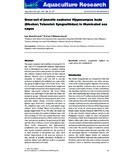Grow-out of juvenile seahorse Hippocampus kuda (Bleeker; Teleostei: Syngnathidae) in illuminated sea cages
Share
抄録
This paper examines the feasibility of rearing 10–15-day- and 0.7–1.5-month-old seahorse Hippocampus kuda in illuminated sea cages to continue existing hatchery protocols to mass produce H. kuda for trade and enhance depleted wild stocks in their natural habitats. Thawed Acetes (a planktonic crustacean abundant in inshore seas) was fed to juvenile seahorses in lighted and unlighted sea cages while one group in lighted cages was not fed Acetes. After 10–12 weeks of rearing, both mean body weight and stretch height increased in all treatment groups, with lighted cage-reared seahorses fed Acetes being heavier (2 g) and longer (8 cm) than the other two treatment groups. Although instantaneous growth rates declined during the rearing period, these were generally higher among Acetes-fed seahorses in lighted cages (0.02–0.07) compared with those in the unlighted cages with Acetes and lighted cages without Acetes feeding. Mean survivorship in all groups ranged from 9% to 74% after the trials, but mean survivorship of juveniles in lighted cages with Acetes feeding (9–74%) was consistently lower than the two treatment groups as a likely result of crustacean and piscine predators being attracted by light and the odour of leftover Acetes in the lighted cages. These results demonstrate that light-attracted zooplankton prey supplemented by Acetes feeding may provide essential nutrients for the growth of H. kuda juveniles in illuminated sea cages. With further improvement in the grow-out protocol, it may provide a possible alternative livelihood to seahorse fishers and sufficient seed to re-populate depleted wild stocks of H. kuda.
Suggested Citation
Garcia, L. M., & Hilomen-Garcia, G. V. (2009). Grow-out of juvenile seahorse Hippocampus kuda (Bleeker; Teleostei: Syngnathidae) in illuminated sea cages. Aquaculture Research , 40(2), 211-217. https://doi.org/10.1111/j.1365-2109.2008.02084.x
主題
Taxonomic term
Collections
- AQD Journal Articles [1231]



